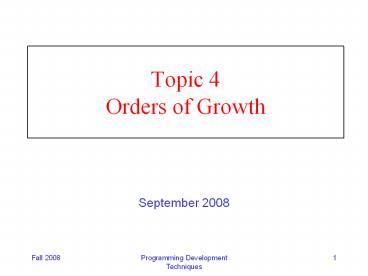Topic 4 Orders of Growth - PowerPoint PPT Presentation
Title:
Topic 4 Orders of Growth
Description:
Iterative exponentiation ; computes b to the n (define (exponent-i b n) (ipwr 1 b n) ... Exponentiation. bn = 1 if n = 0 = b * bn-1 if n 0 ... – PowerPoint PPT presentation
Number of Views:35
Avg rating:3.0/5.0
Title: Topic 4 Orders of Growth
1
Topic 4Orders of Growth
- September 2008
2
Orders of growth
- When a procedure is called, how do time and
memory grow as a function of the size of the
input? - Size of an integer its value
- Size of a string its length
- Size of a graph structure of nodes or of
links
3
A definition
- Let R(n) amount of resource (time, memory) used
when n size of input - R(n) has order of growth T(f(n)) if there exist
constants k1 and k2 s.t. - k1 f(n) R(n) k2 f(n)
- for all sufficiently large n.
4
Theta(polynomial)
- If R(n) is a polynomial such as
- a0 a1 n1 a2 n2 a3 n3 ... am
nm - then R(n) has order of growh T(nm).
5
Recursive factorial
- For both time and memory, recursive fac(n) has
order of growth T(n) because the number of steps
grows proportionally to the input n. - R(n) R(n-1) k
- takes a positive integer and returns its
factorial - (fac 1) 1 if ngt1, then (fac n) ( n (fac
(- n 1))) - (define (fac n)
- (if ( n 1)
- 1
- ( n (fac (- n 1)))))
6
Iterative factorial
- For time, ifac(n) has order of growth T(n)
- For memory, ifac(n) has order of growth T(1)
- k1 1 amount of memory k2 1
- iterative version of factorial
- takes a positive integer and returns its
factorial - (define (faci n)(ifac 1 1 n))
- helping fn for iterative version of factorial
- (define (ifac val cur-cnt max)
- (if (gt cur-cnt max)
- val
- (ifac ( cur-cnt val)
- ( cur-cnt 1)
- max)))
7
Orders of Growth
- Orders of growth provide only a crude description
of the behavior of a process. - This is still often very useful especially as
numbers (ns) are very large. - The difference between a process that is linear
(O(n)) versus O(n2) can mean the difference
between being able to run the algorithm on a
particular input and not being able to run it.
8
Exponentiation
- bn 1 if n 0
- b bn-1 if n gt 0
- raises b to the nth power
- where n is a positive integer
- (define (expt b n)
- (if ( n 0)
- 1
- ( b (expt b (- n 1)))))
- T(n) in both time and space.
9
Can we do better?
- We could do better by developing a procedure that
generated a linear iterative process rather than
a recursive one.
10
Iterative exponentiation
- computes b to the n
- (define (exponent-i b n)
- (ipwr 1 b n))
- val contains intermediate value
- val b(n-ctr)
- (define (ipwr val b ctr)
- (if ( ctr 0)
- val
- (ipwr ( b val) b (- ctr 1))))
11
Exponentiation
- bn 1 if n 0
- b bn-1 if n gt 0
- For both time and memory, T(n) if process is
recursive. - For memory, iterative process can be T(1)
12
- Notice Computing b8
- b (b (b (b (b (b (b b))))))
- But
- b2 b b
- b4 b2 b2
- b8 b4 b4 I can do the
computation in far fewer steps! - This works for exponents that are powers of 2.
In general - bn (bn/2)2 if n is even (NOTE book
has error!) - b bn-1 if n is odd
13
Faster code
- (define (fast-pwr b n)
- (cond (( n 0) 1)
- ((even? n)
- (square
- (fast-pwr b (/ n 2))))
- (else
- ( b
- (fast-pwr b
- (- n 1))))))
14
Analysis (watch it run)
- At least every other recursive call has an even
input - R(n) R(n/2) k
- For time and memory, has order of growth T(log2 n)

